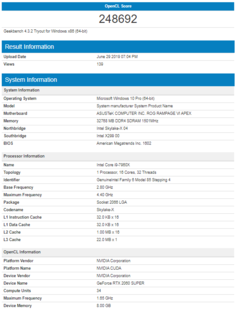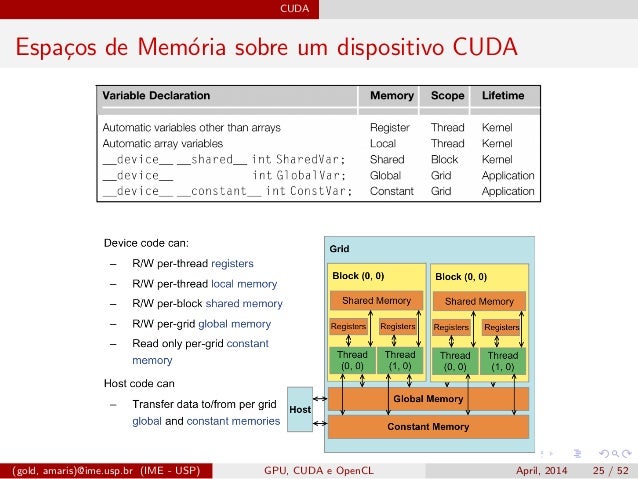

- #CUDA VS OPENCL BENCHMARK HOW TO#
- #CUDA VS OPENCL BENCHMARK INSTALL#
- #CUDA VS OPENCL BENCHMARK REGISTRATION#
- #CUDA VS OPENCL BENCHMARK ANDROID#
- #CUDA VS OPENCL BENCHMARK SOFTWARE#
As a standard, it contains all of the necessary parts, namely run-time code creation and sufficient support for heterogeneous computing. REG2(UnaryOp, SYCL, "Sqrt", functor::sqrt, float, double) REG3(UnaryOp, GPU, "Sqrt", functor::sqrt, float, Eigen::half, double) REG5(UnaryOp, CPU, "Sqrt", functor::sqrt, float, Eigen::half, double,
#CUDA VS OPENCL BENCHMARK REGISTRATION#
Let’s see the sample code for registration All of it is single-source C++ when using SYCL, therefore it’s possible to integrate the SYCL back-end to TensorFlow in a non-intrusive way. TensorFlow to OpenCL translation would necessitate scribbling the kernels in OpenCL C and distinct codebases, both of which would be difficult to maintain.
#CUDA VS OPENCL BENCHMARK SOFTWARE#
An OpenCL system is divided into host and device components, with host software developed in a general programming language like C or C++ and generated for running on a host CPU using a normal compiler. OpenCL allows a wide range of accelerators to be used, involving multi-core CPUs, GPUs, DSPs, FPGAs, and specialized hardware like inferencing engines. Print("Time done:", datetime.now() - startTime) Print("Shape:", shape, "Device:", d_name) With tf.Session(config=tf.ConfigProto(log_device_placement=True)) as session: Ran_matrix = tf.random_uniform(shape=shape, minval=0, maxval=1)ĭ_operation = tf.matmul(ran_matrix, tf.transpose(ran_matrix)) > he1 = tf.constant('Hi, TensorFlow world!') This line-up will build a new context manager, instructing TensorFlow to use the GPU to accomplish those tasks. With the following command, you may perform a big set of roughly 1500 tests:īazel test -test_lang_filters=cc,py -test_timeout 1500 -verbose_failures -jobs=1 -config=sycl -config=opt - //tensorflow/. It’s a good idea to run the tests to ensure TensorFlow was constructed successfully.
#CUDA VS OPENCL BENCHMARK INSTALL#
Sudo apt install git cmake gcc build-essential libpython3-all-dev ocl-icd-opencl-dev opencl-headers openjdk-8-jdk python3 python3-dev python3-pip zlib1g-dev TensorFlow is based on the Eigen linear algebra C++ library. TensorFlow now includes OpenCL support, which can be implemented using SYCL, thanks to Codeplay. To add OpenCL support to TensorFlow, we need to use ComputeCpp to create an OpenCL version of TensorFlow. $ singularity exec -rocm -bind /etc/OpenCL library://sylabs/demo/blend blender Using the container that has been provided to the Sylabs library, you can run Blender as a graphical programme that will use a local Radeon GPU for OpenCL compute: Permissive licenses offer the fewest limitations and can be used in almost any project.īlender’s most recent versions support OpenCL rendering. The Apache-2.0 License applies to TensorFlow-OpenCL. There are no known vulnerabilities in TensorFlow-OpenCL and no known vulnerabilities in its dependent libraries. There is no apparent advantage, as it is depending on code quality, hardware type, and other factors. Has a large number of high-performance librariesĪlthough it has a large number of libraries that may be used on any OpenCL-compliant hardware, it is not as comprehensive as CUDA. OpenCL, on the other hand, can run on practically any operating system and on a wide range of hardware.Į.g., Android, FreeBSD, Windows, Linux, macOS e OpenCL is an open standard that may be used on a wide range of hardware, including desktop and laptop GPUs.ĬUDA can run on Windows, Linux, and macOS, but it requires NVIDIA hardware to do it. Hadoop, Data Science, Statistics & others CUDA vs OpenCL ComparisonĬompute Unified Device Architecture (CUDA) is a parallel computing design that supports applications that demand a lot of parallel processing. Machine learning has been proposed as a solution to this issue.
#CUDA VS OPENCL BENCHMARK HOW TO#
Because the relative rates of processes fluctuate among the devices, this creates a dilemma in selecting how to partition the work. Because OpenCL allows workloads to be shared by CPU and GPU while running the same programs, programmers can take advantage of both by dividing work across the devices.

Higher-level frameworks and compilers are increasingly using OpenCL as an acceleration target.
#CUDA VS OPENCL BENCHMARK ANDROID#
TensorFlow Lite falls back to OpenGL ES if OpenCL isn’t available, although most mobile GPU vendors supply OpenCL drivers, even if they aren’t exposed to Android app development directly. Over OpenGL ES acceleration, OpenCL provides a 2x inferencing speedup. OpenCL is a standard parallel computing standard for event and data-based parallelism. SYCL is an easy free, cross-platform C++ abstraction layer, while OpenCL(Open Computing Language) is a framework for building applications that execute across heterogeneous platforms. We’re working on adding support for OpenCLTM devices to the TensorFlow framework using SYCLTM to give developers access to a wider range of processors. TensorFlow is a machine learning algorithm execution framework based on artificial intelligence concepts.


 0 kommentar(er)
0 kommentar(er)
